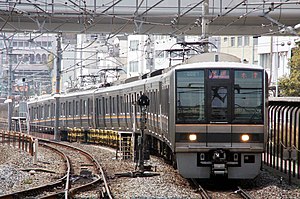| This article needs additional citations for verification. Please help improve this article by adding citations to reliable sources. Unsourced material may be challenged and removed. Find sources: "JR Tōzai Line" – news · newspapers · books · scholar · JSTOR (June 2018) (Learn how and when to remove this message) |
| JR Tōzai Line | |
|---|---|
 | |
 207 series EMU 207 series EMU | |
| Overview | |
| Native name | JR東西線 |
| Owner | Kansai Rapid Railway Co., Ltd. |
| Locale | Osaka and Amagasaki |
| Termini | |
| Stations | 9 |
| Service | |
| Type | Commuter rail |
| System | Urban Network |
| Operator(s) | |
| Rolling stock | 207 series EMU 321 series EMU |
| Daily ridership | 233,577 (daily 2015) |
| History | |
| Opened | 8 March 1997; 27 years ago (1997-03-08) |
| Technical | |
| Line length | 12.5 km (7.8 mi) |
| Number of tracks | Double-track |
| Track gauge | 1,067 mm (3 ft 6 in) |
| Electrification | 1,500 V DC (overhead lines) |
| Operating speed | 90 km/h (56 mph) |
| Signalling | Automatic Closed block |
| Train protection system | ATS-P |
The JR Tōzai Line (JR東西線, Jei-āru Tōzai-sen) is one of several commuter rail lines and services in the Osaka-Kobe-Kyoto Metropolitan Area, operated by West Japan Railway Company (JR West). The line, whose name literally means "east-west", runs underground through central Osaka and connects the Gakkentoshi Line at Kyobashi Station in Osaka and the JR Takarazuka Line and the JR Kobe Line at Amagasaki. All stations on this line are in the city of Osaka, except for the western terminus in Amagasaki, Hyōgo Prefecture.
Basic data
| This section does not cite any sources. Please help improve this section by adding citations to reliable sources. Unsourced material may be challenged and removed. (May 2013) (Learn how and when to remove this message) |
- Operators, distances: 12.5 km / 7.8 mi.
- West Japan Railway Company (Category-2, Services)
- Kansai Rapid Railway [ja] Co., Ltd. (Category-3, Tracks)
- Railway signalling:Automatic
- CTC centers:Ōsaka Operation Control Center
- CTC system:JR Takarazuka – JR Tozai – Gakkentoshisen traffic control system (JR west traffic control system)
Operation
All trains are local services and stop at every station on the line. Some trains terminate at Amagasaki, but most westbound trains continue on the Kobe Line to Nishi-Akashi and on the Takarazuka Line to Tsukaguchi and Takarazuka. All eastbound trains continue past Kyobashi on the Gakkentoshi Line.
History
The line was initially proposed in 1971 by Japanese National Railways (JNR) as a link between the Katamachi Line, which connected Osaka to its eastern suburbs, and Fukuchiyama Line, which connected the city to its northwestern suburbs. Osaka's municipal government had maintained tight controls over transportation within the city, and most intercity lines terminated outside the city center. The line, provisionally known as Katafuku Line (片福線, Kata- from Katamachi, -fuku from Fukuchiyama), and would give commuters a single-seat ride from the suburbs and an east-west connection through central Osaka.
A permit to lay the track was given 10 years later, but the project stopped because of JNR's financial problems.
In 1988, after JNR privatized and split into Japan Railway companies, West Japan Railway Company formed a private-public entity called Kansai Rapid Railway Co., Ltd. (関西高速鉄道株式会社, Kansai kōsoku tetsudō kabushiki gaisha) with the prefectural governments of Osaka and Hyōgo, and the cities of Osaka and Amagasaki.
The line was completed and opened as JR Tozai Line in 1997.
Stations
Rolling stock
- 207 series (from 1991)
- 321 series (from 2005)
Former
- 223-6000 series (from March 2008, until March 2011)
References
- "平成27年 大都市交通センサス 首都圈報告書" (PDF). P.92. 国土交通省.
- New Station numbers. West Japan Railway News Release July 20, 2016